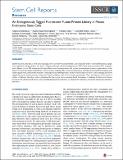An Endogenously Tagged Fluorescent Fusion Protein Library in Mouse Embryonic Stem Cells
Author(s)
Harikumar, Arigela; Edupuganti, Raghu Ram; Sorek, Matan; Azad, Gajendra Kumar; Markoulaki, Styliani; Sehnalová, Petra; Legartová, Soňa; Bártová, Eva; Farkash-Amar, Shlomit; Jaenisch, Rudolf; Alon, Uri; Meshorer, Eran; ... Show more Show less
Download1-s2.0-S221367111730379X-main.pdf (2.843Mb)
PUBLISHER_CC
Publisher with Creative Commons License
Creative Commons Attribution
Terms of use
Metadata
Show full item recordAbstract
Embryonic stem cells (ESCs), with their dual capacity to self-renew and differentiate, are commonly used to study differentiation, epigenetic regulation, lineage choices, and more. Using non-directed retroviral integration of a YFP/Cherry exon into mouse ESCs, we generated a library of over 200 endogenously tagged fluorescent fusion proteins and present several proof-of-concept applications of this library. We show the utility of this library to track proteins in living cells; screen for pluripotency-related factors; identify heterogeneously expressing proteins; measure the dynamics of endogenously labeled proteins; track proteins recruited to sites of DNA damage; pull down tagged fluorescent fusion proteins using anti-Cherry antibodies; and test for interaction partners. Thus, this library can be used in a variety of different directions, either exploiting the fluorescent tag for imaging-based techniques or utilizing the fluorescent fusion protein for biochemical pull-down assays, including immunoprecipitation, co-immunoprecipitation, chromatin immunoprecipitation, and more. Keywords: embryonic stem cells; imaging; live imaging; fluorescence; differentiation; pluripotency; GFP; microscopy; DNA damage; protein dynamics
Date issued
2017-09Department
Massachusetts Institute of Technology. Department of BiologyJournal
Stem Cell Reports
Publisher
Elsevier
Citation
Harikumar, Arigela et al. “An Endogenously Tagged Fluorescent Fusion Protein Library in Mouse Embryonic Stem Cells.” Stem Cell Reports 9, 4 (October 2017): 1304–1314 © 2017 The Authors
Version: Final published version
ISSN
2213-6711